San Gimignano is a romantic glamor girl of Tuscany. It’s one of Italy’s best preserved and most beautiful medieval villages.
As you stroll San Gimignano’s cobbled lanes, you’ll feel like you’ve stepped into a time machine.
Nicknamed the “Medieval Manhattan,” San Gimignano is famous for its “Bella Torres” or “Beautiful Towers.”
The walled town known for its striking skyline of 14 honey-colored towers.
But there’s more to this town than just its towers. Art enthusiasts will find plenty to admire here, including fresco cycles by early Renaissance masters.
The town’s beauty is so remarkable that it almost resembles a stage set, a quality that has earned it UNESCO World Heritage status.
In this guide, I take you through the top attractions in San Gimignano and provide helpful tips for your visit. And for those struggling with the pronunciation, it’s San-Jee-Menn-Yay-Noh.
Mini History of San Gimignano
San Gimignano has a rich history that stretches back to the ancient Etruscans, long before the rise of Ancient Rome. It gained prominence as a key stop on the Via Francigena, the pilgrimage route stretching from Rome to Canterbury.
This influx of pilgrims boosted the local economy, particularly in the saffron and wine trades, enabling the town’s merchants and patrician families to accumulate wealth. To display their newfound prosperity and influence, they began the trend of building tall towers.
However, San Gimignano’s growth was dramatically cut short by the Black Death in 1348. The town suffered greatly from successive waves of plague and famine, leading to its decline into obscurity.
It wasn’t until Florence took over the weakened town in 1354 that its fortunes began to change. San Gimignano eventually resurfaced as a popular tourist destination in the 19th century.
Today, San Gimignano is world-renowned for its stunning array of towers. Despite its small size, this feature has whimsically earned it the nickname “Medieval Manhattan,” a title that might be a bit overstated but adds to its unique charm.
And yet, San Gimignano does have a sense of mad verticality. 14 towers still remain standing in San Gimignano.
There’s a long history explaining San Gimignano’s architectural eccentricity. The towers are a vestige of a time when there was no centralized form of government in most of Europe.
Oligarchs were the norm. Towns were organized as urban feudal societies, with wealthy merchants effectively ruling.
These aristocrats wanted to flaunt their power and money. But there was no room for great palaces. The only way to build was vertically. So they built “tower houses.”
At one time, in the 12th and 13th centuries, there were more than 70 towers in San Gimignano.
Wealthy families competed to see who could built the tallest tower. Their motto was the higher the tower, the greater the power.
Yet these vanity towers weren’t exactly fancy. There were wooden stairs (no way to install elevators now). The ground floor held workshops. The second level was the living quarters. Kitchens were located on the top floor.
Sometimes families built their tower houses near each other. The clusters were connected by porches.
Eventually, zoning ordinances were passed, proclaiming that nothing could be taller than Torre Grossa, the tower connected to City Hall.
Some of the towers were cut down. What’s left is a testament to the palpable history of that ancient world.
What To See & Do in San Gimignano
1. Historic Center
The historic center of San Gimignano is stunning. One main path through town links the gates at both ends.
You can walk from one to another in about 10 minutes. But you may want to book a 2 hour guided walking tour to get an overview of the town’s history and top attractions.
The central square is the Piazza del Duomo.This piazza is where most of San Gimignano’s historic attractions are all jammed together in a compressed urban setting.
You’ll be enveloped by seven towers, including the two tallest — Torre Grossa and Torre Rognosa.
Piazza della Cisterna is San Gimignano’s other main square. It’s one of Italy’s most beautiful squares. It’s named for the well in its center, an ancient device that collected rain water for the citizens. Nowadays, it serves as a wishing well.
Rustic-yet-proud medieval facades rise in a tight huddle around the well. During high tourist season, the square is dotted with chairs and tiny tables and shops display their wares.
There are plenty of shops to purchase saffron, olive oil, gelato, or Vernazza and Chianti wines.
Gelateria Dondoli is a well known and very popular shop, ranked one of the best gelatarias in Italy.
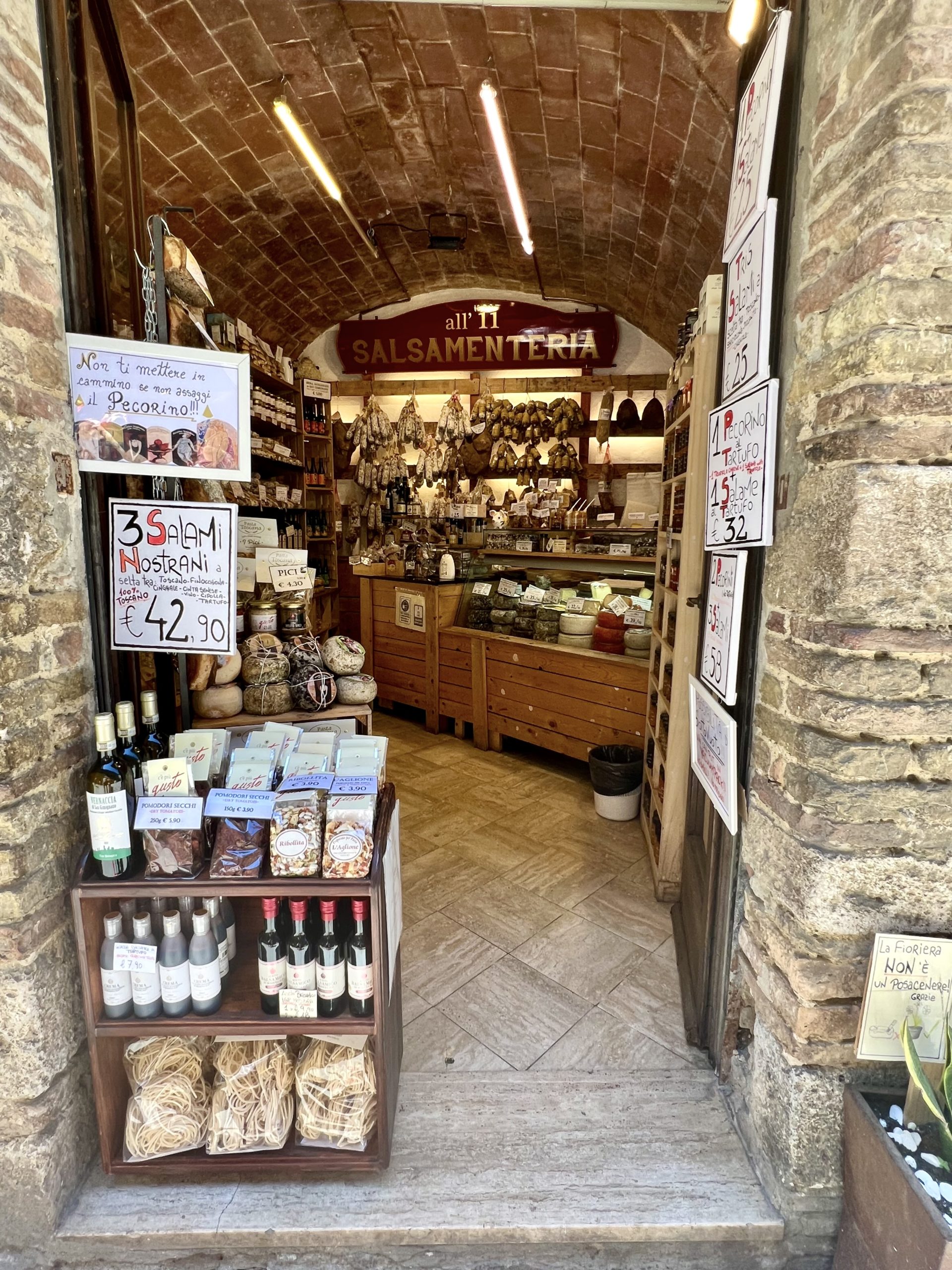
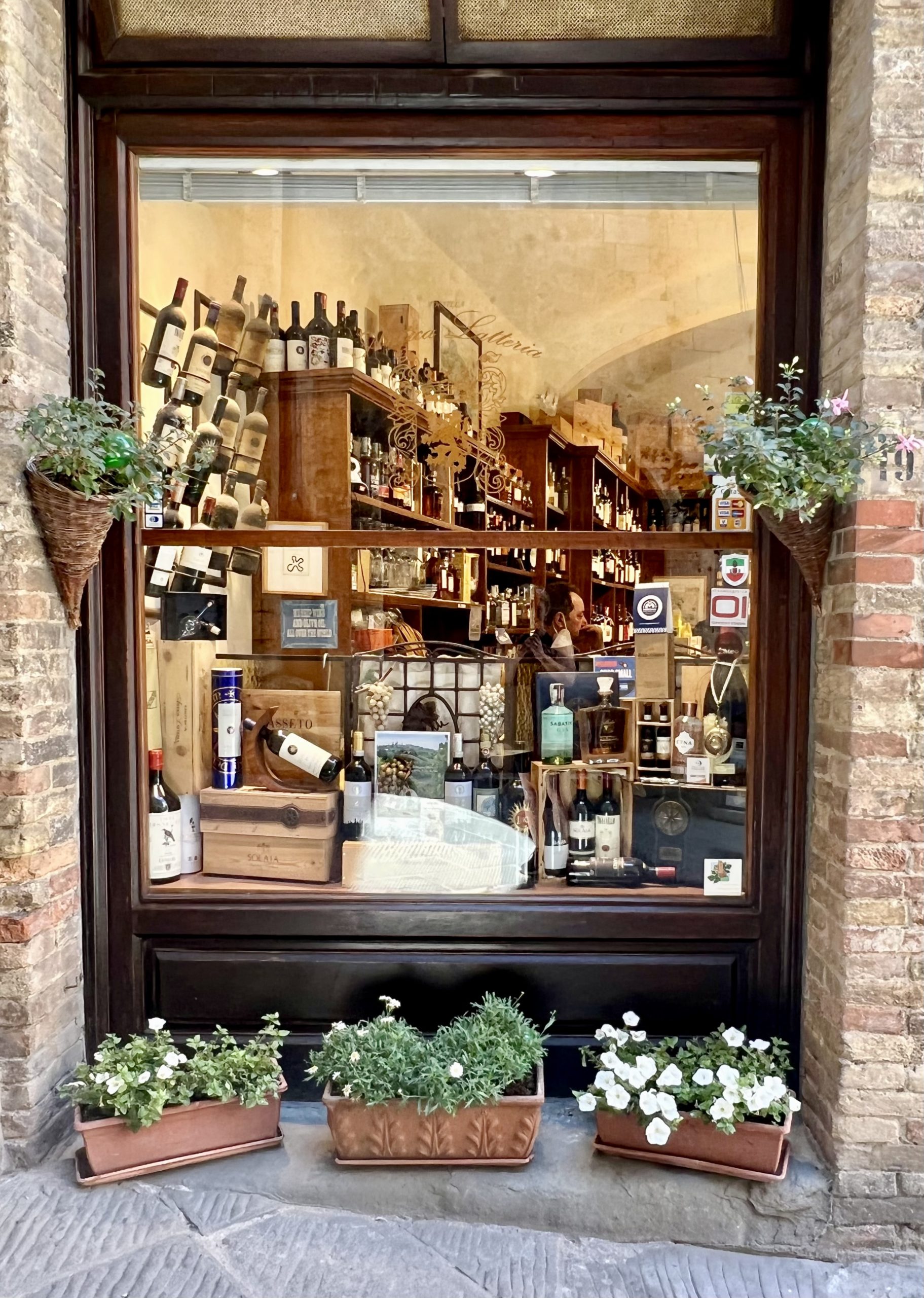
Piazza della Cisterna is also where San Gimignano’s Thursday and Saturday markets are held. The piazza has been used as a filming location for a few movies, including Zefferelli’s Tea With Mussolini.
Just round the corner from Piazza del Duomo is Piazza delle Erbe. There, you’ll find a small marketplace and two more tall towers – the Torri dei Salvucci.
The Salvucci family built these towers to show dominance over the town’s mayor, who owned Torre Rognosa.
Instead of one tower, the Salvucci built two. And both towers were taller than Torre Rognosa. Outraged, the mayor ordered that the Torri dei Salvucci be trimmed down so that it was shorter than Torre Rognosa.
2. San Gimignano Cathedral
In the Piazza del Duomo, you’ll find the 11th century Duomo of San Gimignano.
It’s called the Collegiate Church of Santa Mary of the Assumption and nicknamed the Duomo or the Colegiata. It’s the best thing to do in San Gimignano, a treasure chest of art.
Completed in 1163, the Duomo is a beautiful (mostly) Romanesque church. It’s austere on the outside with a feast of frescos on the inside.
The interior has a richly painted nave with striped arches and rather abstract Romanesque capitals.
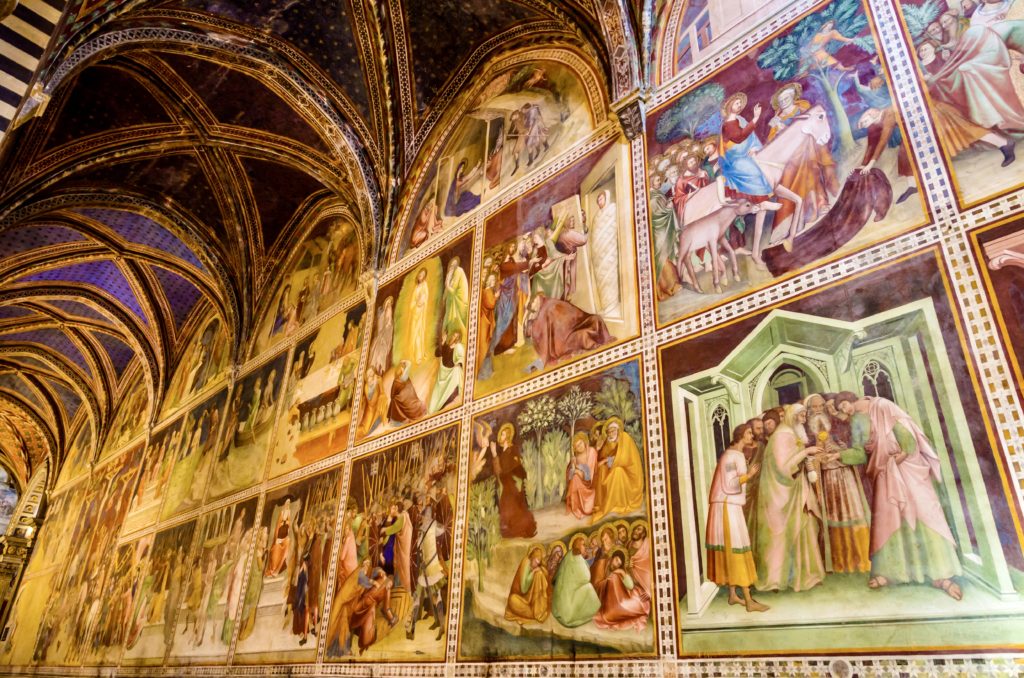
Most people don’t venture inside. But you definitely should. The frescos are as much of a draw in San Gimignano as the towers.
The Duomo boasts some of the most important paintings of the Middle Ages.
The frescos were painted by Early Renaissance luminaries such as Ghirlandaio, Benozzo Gozzolli, and Taddeo di Bartolo. The cathedral is rather dark. But the frescos are lit by artificial light.
As is typical of the 14th century, New Testament subject matter is on one side of the cathedral and Old Testament subject matter is on the other.
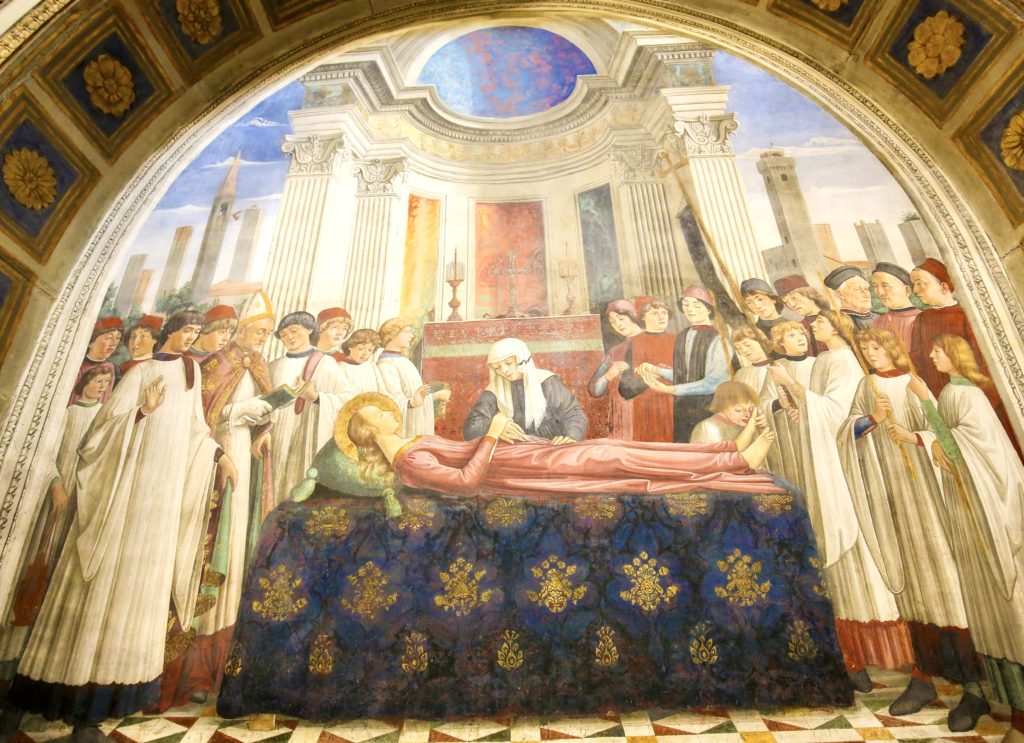
The comic book type frescos are sometimes referred to as the “poor man’s bible.” They helped the citizens relate to Jesus.
Ghirlandaio Frescos
In the Chapel of Saint Fina, there are some excellent paintings by early Renaissance master Ghirlandaio, who was Michelangelo’s teacher. The chapel was one Ghirlandaio’s first known commission, painted in 1477-78.
The frescos depict airy scenes of the life and death of the pious Saint Fina. Fina is the patron saint of San Gimignano, with a tragic made for TV life story.
The girl was sick for 10 years, passing time on a board in mystic devotion and without complaint. Legend holds that when she died, yellow viola flowers blossomed from the board and other miracles occurred.
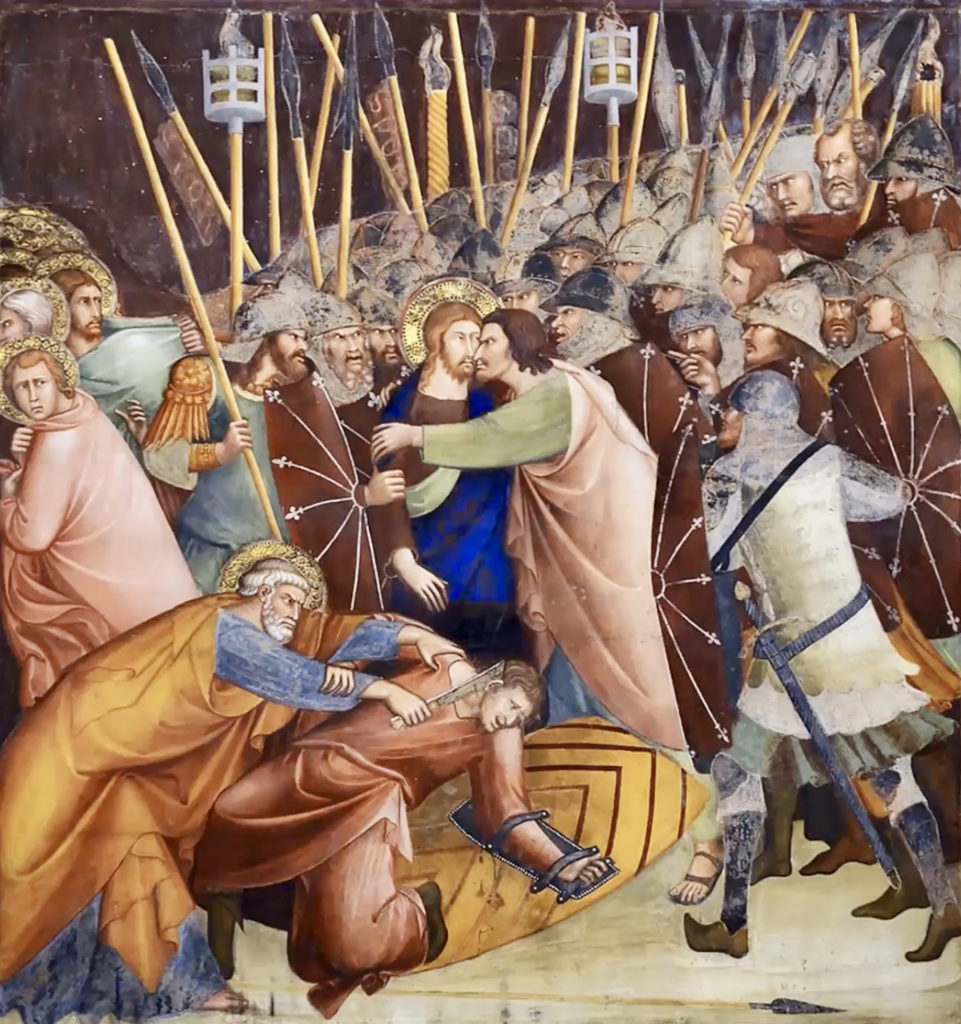
Barna da Siena Frescos
There’s also a violent and rather sinister fresco cycle in the Duomo, typical of the school of painting after the Black Death.
As I mentioned above, because San Gimignano was located on the pilgrim route, it was decimated by plague time and time again.
The three bands of post-Black Death frescos were reputedly painted by the mysterious Sienese painter Barna da Siena. Siena allegedly fell to his death from scaffolding while painting the frescos. As a result, the frescos are sometimes considered cursed.
You read the frescos from right to left (which is unusual). In their emotive characters, the frescos were clearly influenced by Giotto, the greatest painter of the 14th century.
The better executed frescos are the ones with a darker subject matter. Just look at the malignant and shifty expressions on the face of Judas in the Pact of Judas and The Kiss of Judas. The most graphic image is the apocalyptic Crucifixion.
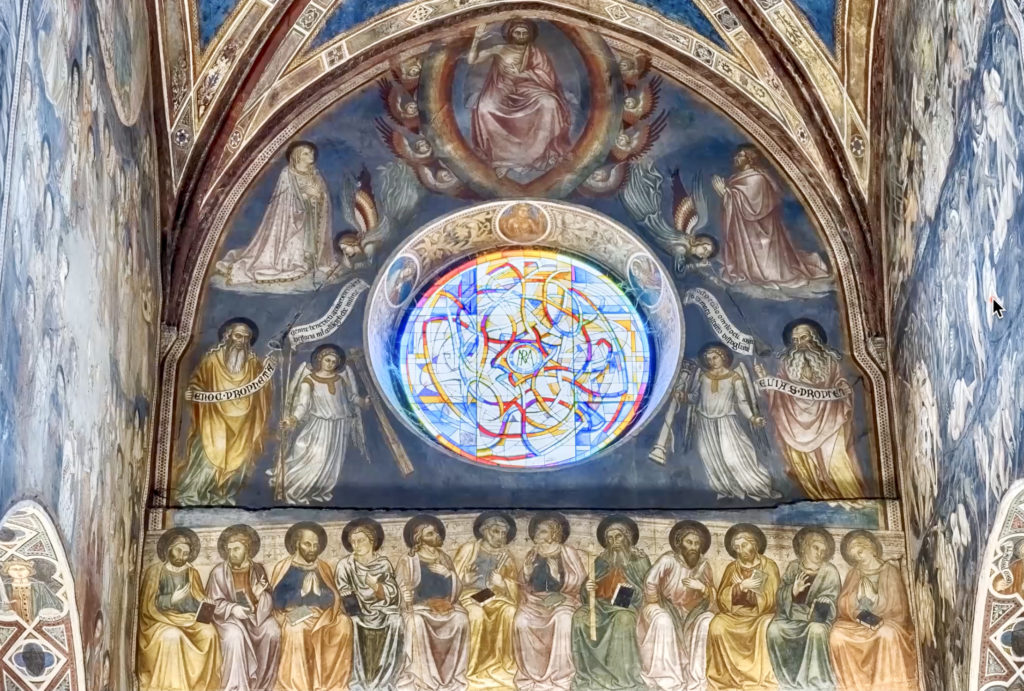
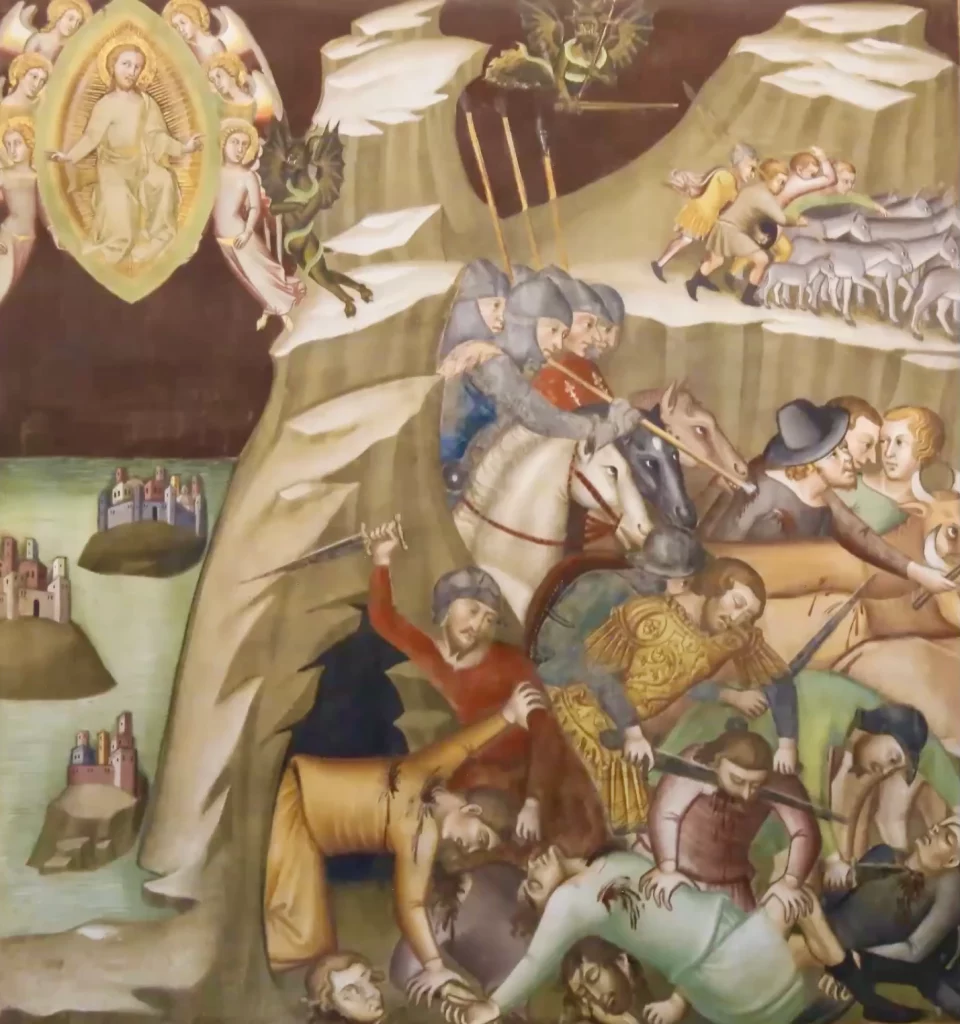
Di Fredi Frescos
The Old Testament scenes on the other side of the nave were painted by Bartolo di Fredi. These paintings are signed and dates, so there’s no mystery of who painted them.
At the entrance wall of the cathedral, there are more creepy-dark frescos by Bartolo’s son, Taddeo, dated 1394. It’s a terrifying Last Judgment scene.
The hell imagery is scorching. All the sinner are punished in horrible ways.
Gozzolli Painting
Finally, there’s a beautiful painting of the Martyrdom of St. Sebastian Benozzo Gozoli.
This is the same artist who painted a private chapel for the Medici family in Florence’s Medici-Ricardi Palace.
Carrying through the dark theme, St. Sebastian has a huge number of arrows sticking out of his body. But he does, at least, smile.
The entrance fee for the Duomo is 16 euros. It includes a 20+ minute audio guide, which help you appreciate the church.
3. Palazzo Comunale | Palazzo del Popolo
This late 13th century palazzo is the seat of the Town Hall. This must visit attraction is also known as the Palazzo del Popolo. There’s also an adjacent public loggia that’s comparable to the Loggia dei Lanza in Florence.
The palazzo is Romanesque in style, belfried and balconied. The facade has arched windows.
The bottom half is stone and the top half is brick. The palace has a beautiful courtyard filled with frescos.
The upper floors of the palace houses the town’s Civic Museum. If you’re short on time or not a fan of Early Renaissance art, these museums are skippable. The Duomo eclipses them in terms of the quality of art.
The Civic Museum’s painting collection includes minor works by Pinturricchio, Filippino Lippi, and other 13th to 15th century painters from the Florentine and Sienese schools.
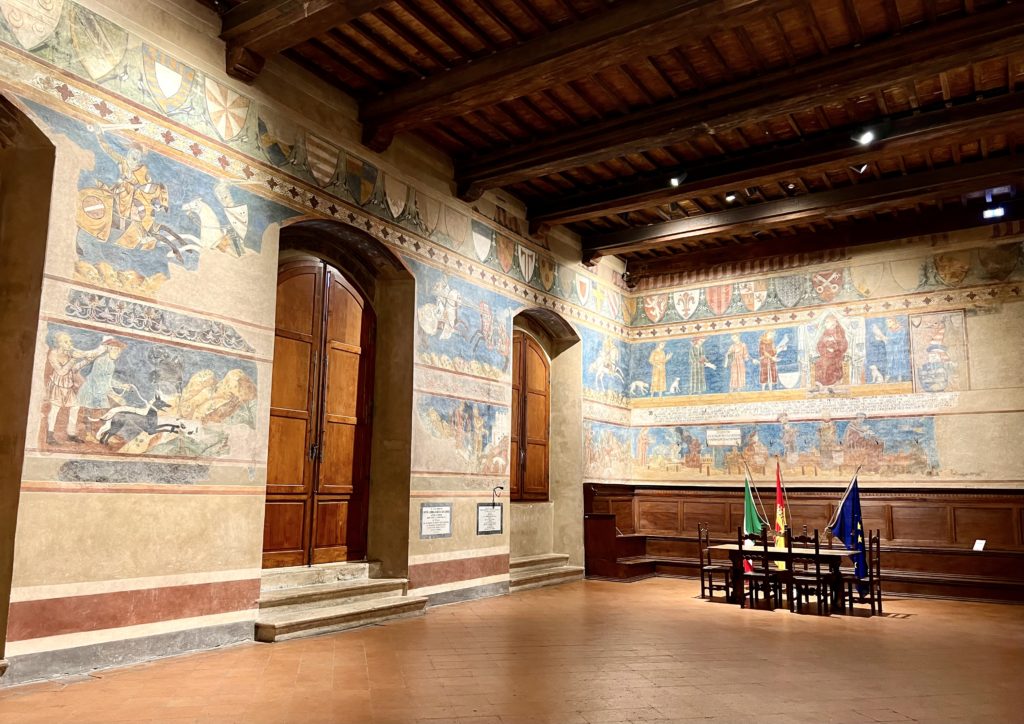
The museum’s highlight are two important rooms: the Camera del Podesta (Room of the Mayor) and the Sala Dante.
The Camera has allegorical frescos from 1306 painted by Memmo de Filippuccio. They depict Scenes of Married Life.
The tales of love are didactic, showing realistic scenes of both sacred (marital) and profane (illicit) love. You’ll see racy scenes of couple bathing together and hopping into bed naked.
The Sala Dante is named after the famous poet who stayed there. The walls are covered in frescos by Lippo Memmi, who was the son of Memmo. There’s an especially majestic Virgin and Child.
4. Climb Torre Grossa
If you like to climb things, you can climb the Torre Grossa adjacent to the City Hall for spectacular views. It’s one of the best things to do in San Gimignano.
At 200 feet, this is San Gimignano’s tallest tower, dating from 1311. Legend holds that Dante lived in this tower while in San Gimignano.
Climbing the tower is not for the faint of heart though. The 218 cantilevered steps zig and zag as you head to the roof.
The steps are fairly steep at the top and you have to watch your head sometimes. At the very end, you climb a steep ladder to reach the top.
If you don’t want to climb the ladder, there are views on the floor below. But I thought the the views are worth the hike and medieval vertigo.
5. Climb Torre Salvucci
The twin Salvucci towers are now available for rent as an Air Bnb.
When they’re not rented, you can climb the 143 steps for more views.
6. Fortress of Rocca of Montestaffoli
If you need a break from the crowds head up to the 14th century ruins of the Rocca Fortress. It’s a 5 minute climb from the Piazza del Duomo. And a much easier climb than Torre Grossa.
La Rocca is the ruins of a fort that once guarded the town. As befitting a medieval fortress, it looks architecturally ferocious.
The Florentines erected the fortress when they took over in 1353. In 1555, it was demolished on the orders of Cosimo I de Medici. Only a tower and fragments of the walls survive.
The Rocca is mostly just a shell, used as a venue for concerts and the like. Inside there’s a thick tower in the far corner that you can climb for panoramic views of the surrounding countryside.
7. Church of Sant’Agostino
The 13th century Sant’Agostino is directly uphill from the cathedral. It’s the second largest church in San Gimignano. Like the Duomo, it has a simple exterior and an elegantly decorated interior.
The main reason to visit the church is the Benozzo Gozzoli frescos in the choir behind the high altar. The frescos depict the life of Saint Augustine.
There’s also a Gozzolli fresco of Saint Sebastian, a saint who (like the town itself) was plagued with bad fortune.
The cycle of St Augustine is a favorite theme of Tuscan narrative art from the mid 14th century. This cycle pairs with the fresco cycle of the Legend of the True Cross by Piero della Francesca in Arezzo and the Passion Pulpit and Resurrection Pulpit by Donatello in the Basilica of San Lorenzo in Florence.
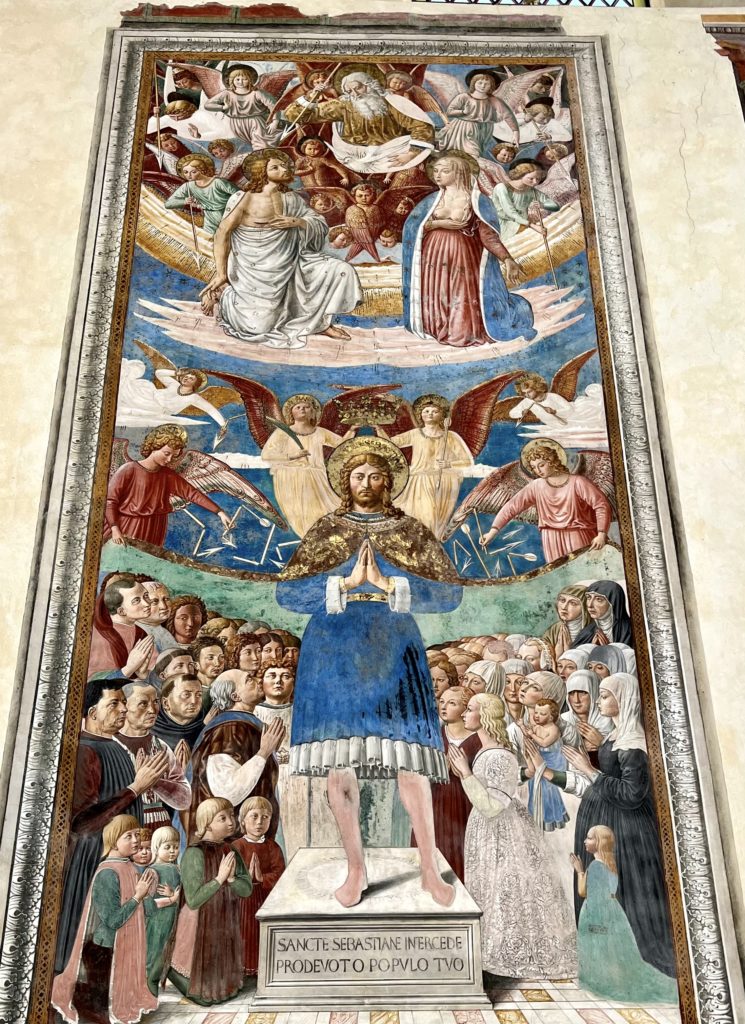
8. Church of San Lorenzo in Ponte
If you want to complete the fresco trail in San Gimignano, you should pop into this small church. It has a large fresco cycle depicting an enthroned Christ with Mary and the apostles.
9. Other Museums in San Gimignano
If you’re in San Gimignano for more than one day, there are some other museums you can put on your itinerary.
Archaeological Museum
The Archaeological Museum is located in the Santa Chiara Complex.
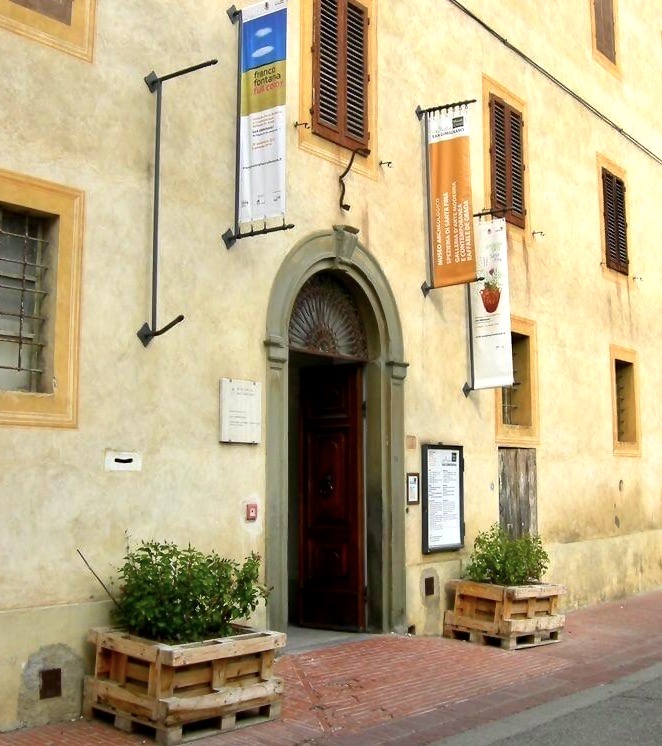
It has a collection of artifacts from San Gimignano, including some Etruscan and Roman pieces. There are mostly everyday items on display, like funerary urns, necklaces, ceramics, and metal mirrors.
The Herbarium of Santa Fina is also part of the Archaeological Museum. It’s a partial reconstruction of a medieval pharmacy. It gives you a sense of the potions that were popular in the Middle Ages.
Modern and Contemporary Art Gallery
This small museum showcases avant garde art, mostly by local artists. It also has a temporary exhibition space, where you will find works by more famous artists.
Torture Museum
The Museo della Tortura is inside the Torre della Diavola. If you like a grisly museum, this is your place. Medieval torture was used both to extract confessions and to punish the convicted prior to execution.
The Torture Museum displays a nasty toolkit of medieval artifacts — iron maidens, racks, spiked inquisition chairs, and guillotines. The accompanying scientific descriptions are written in a matter of fact detached manner, which adds to the creepy atmosphere.
They explain precisely how these instruments were used on people. Wax figures also demonstrate the effectiveness of the torture devices in graphic detail.
If you don’t have a high tolerance for disgusting things, you may want to cut short your visit. Even if you do have a strong stomach, the museum may seem shocking.
Museum of Sacred Art
The Museum of Sacred Art adjoins the Duomo. It’s a small museum that houses a collection of religious art.
There’s beautiful courtyard and stairway. The museum is included in a combination ticket with the Duomo.
There are frescoes by Bartolo di Fredi, Benozzo Gozzoli, Taddeo di Bartolo, and Barna da Siena, and Ghirlandaio. The highlight of the museum is the fresco of the Madonna and Child by Bartolo di Fredi.
10. Torre e Casa Campatelli
The Casa Campatelli is an 18th century palazzo. It was rebuilt around a 12th century medieval tower house complex by a prosperous Florentine family, the Cammpatellis.
The family purchased the structure and converted it into an upper middle class home. The palazzo is now a museum, with its the original furnishings and art collections intact. There are some Montelupo ceramics and paintings by Guido Peyron.
A video projection gives you an overview of the palace, a nice snapshot of daily life in the 18th century, and a history of the town.
The palazzo still incorporates the medieval tower. The tower is completely hollow inside, except for the balconies at each landing.
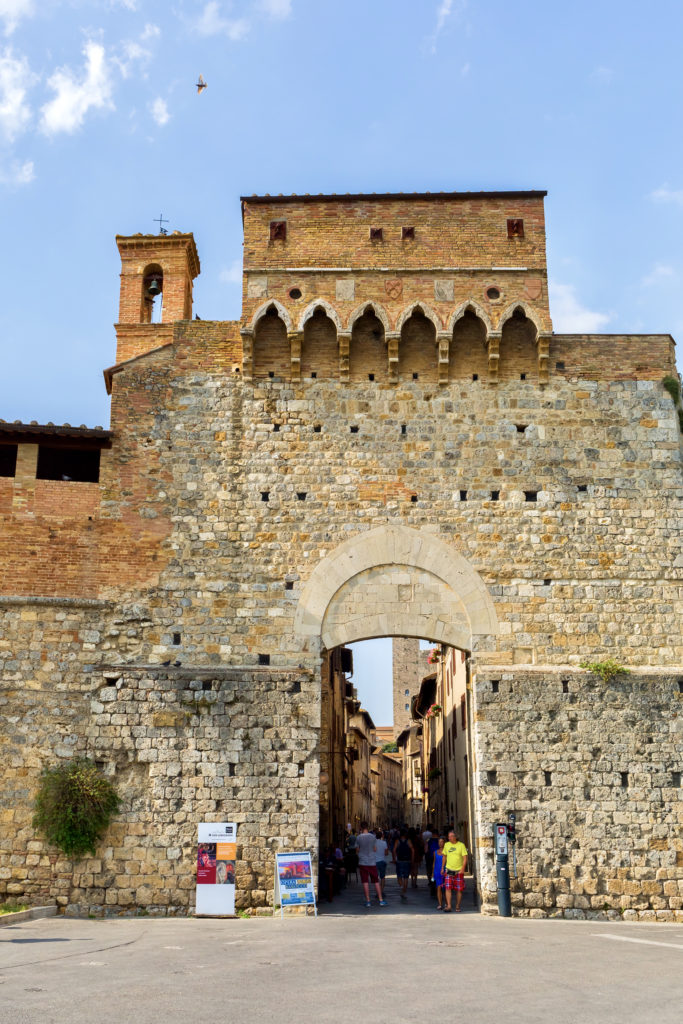
11. City Walls
Before you leave the town, take a walk around the city walls. You’ll find interesting gates such as the such as Porta San Giovanni and Porta San Matteo.
They were built by the Medici family, a powerful Florentine dynasty that controlled San Gimignano in the 15th century.
They are in a reasonably preserved state and encircle the town. The views from the walls are fantastic.
12. Panoramic Viewpoint
When you’re strolling the town, don’t forget to San Gimignano’s Panoramic Viewpoint on Via degli Innocenti. There’s also a restaurant there with outside seating.
Tips For Visiting San Gimignano
1. How To Get To San Gimignano
You can get to San Gimignano by car, bus, or tour.
To get to San Gimignano by bus, leave from either from Siena or Florence and go to Poggibonsi. It’s a 1.5 hour train ride from Florence and a it’s 45-60 minutes from Siena.
From Poggibonsi, it’s a 25 minute bus ride to San Gimignano. The bus drops you in Piazzale del Martiri near Porta San Giovanni.
Be sure to purchase round trip tickets for your bus ride. If not, you can purchase a return ticket in a tobacco shop.
It’s really easiest to have a car to visit San Gimignano. There’s no train station in San Gimignano. And there are no direct bus connections.
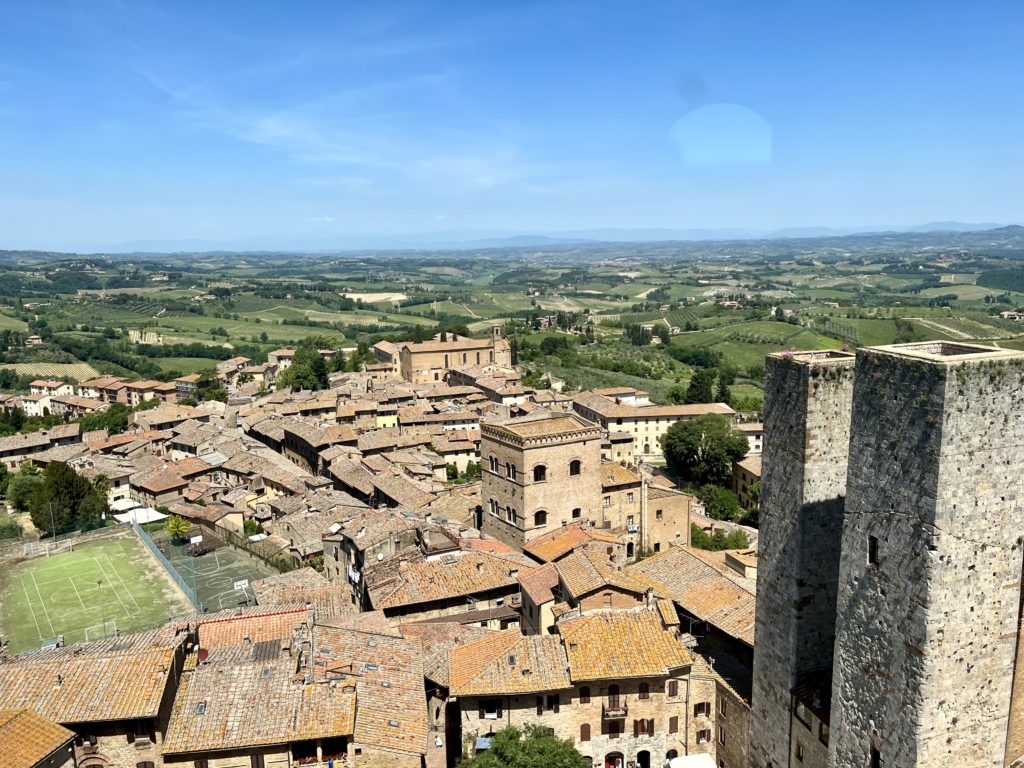
If you are driving, take the Poggibonsi Nord exit off the Florence-Siena highway. It’s then 12 kilometers to San Gimignano. The drive is breathtaking — full of rolling landscapes, olive groves, and grapevines.
Park your car at the bottom of the hill. The town is largely pedestrianized and off limits to vehicles. The most convenient garage is Parcheggio Montemaggio near the Porta San Giovani.
After parking, you have to hike up the hill. There’s also a shuttle bus that drops you in the Piazza Cisterna for a small fee.
You enter via the Porta San Giovani, a medieval doorway dedicated to St. John the Baptist. The city is built around a pilgrimage route that cuts through the heart of San Gimignano.
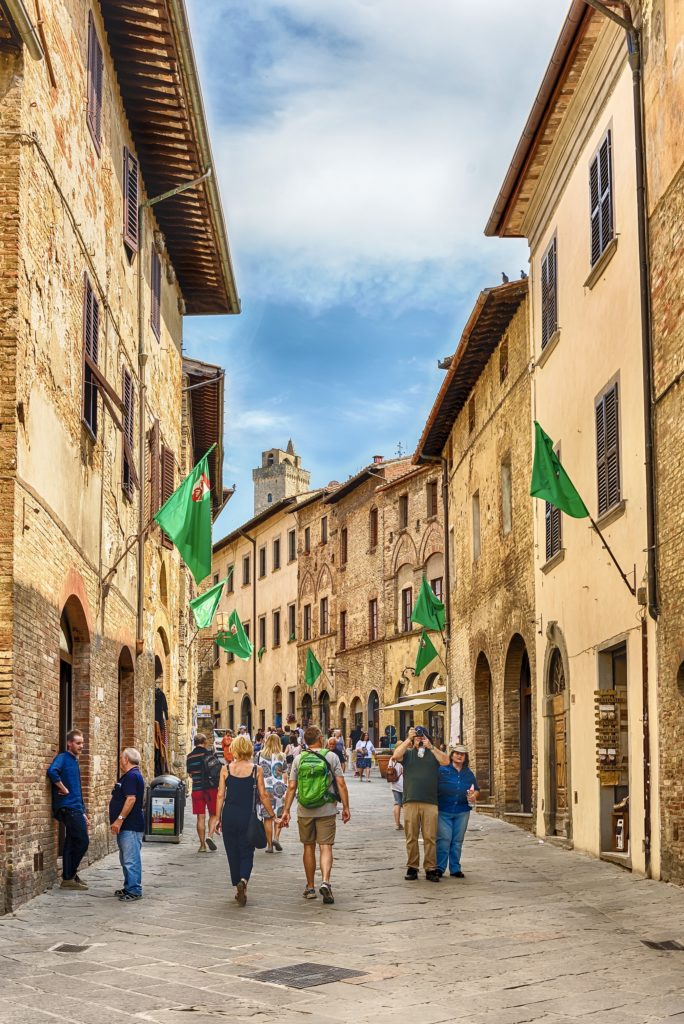
2. Guided Tours of San Gimignano
Because San Gimignano is not exactly easy to get to, you may want to book a guided tour to let someone else do the hard part. There are quite a few different tours leaving from Flroence.
This tour leaves from Florence and includes lunch and a wine tasting. This tour takes you to both San Gimignano and Siena, which, as I discuss below, you can do in one day if you’re pressed for time.
While you’re in San Gimignano, you might consider taking a wine tour, a vineyard dinner with a wine tasting, or a Tuscan cooking class.
You can also take a Chianti region and castle tour from San Gimignano. Or even go horseback riding in the Tuscan countryside.
3. Can You Do San Gimignano and Siena In One Day?
It’s possible to visit both San Gimignano and Siena in one day. The towns are about 45 minutes apart. But I wouldn’t advise it. You’ll be rushed.
If you’re pressed for time and need to squeeze them both in, spend half a day in each town. Start with Siena. See Palazzo Pubblico and the Siena Cathedral complex.
Then head to San Gimignano. Wander the streets and check out the frescos in the Duomo.
4. When To Visit San Gimignano
San Gimignano is undoubtedly a popular destination in Italy, with its charming cobblestone streets and picturesque buildings drawing in tourists from all over Tuscany.
However, this popularity can also mean that the town can feel overcrowded, with the main attractions often swarmed with visitors, particularly during peak season and mid-day.
Adding to the crowds, San Gimignano is also a popular day trip destination, often included in tours that cover multiple locations, such as Siena.
To avoid the crowds, it’s best to visit San Gimignano in the morning when the crowds are still thin, or alternatively, consider staying overnight in the town.
By doing so, you can enjoy the streets and sights of San Gimignano when the crowds have dispersed, giving you a chance to truly savor the town’s unique charm.
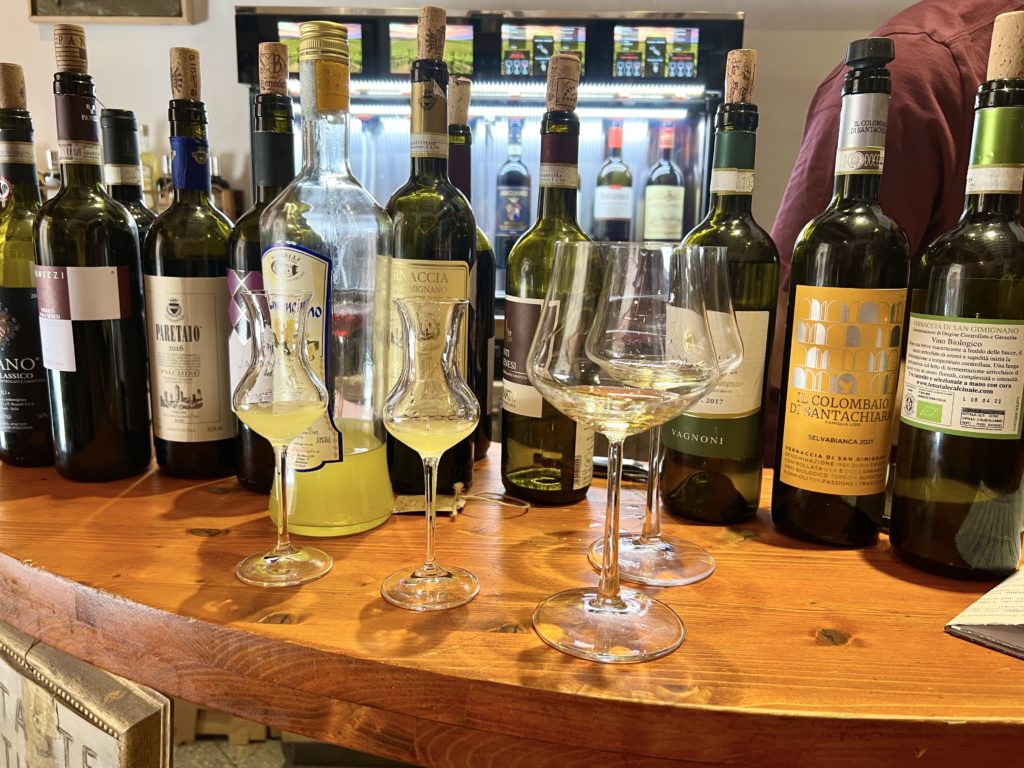
5. The Local Specialties
San Gimignano is home to a local wine known as Vernaccia. Vernaccia di San Gimignano is a crisp dry white wine with citrus fruit flavors, which has been refined in the last decade.
Every storefront and cafe in the town will have this wine. And they’re happy to ship it to you.
Another local specialty is wild boar sausage. Boars eat mostly berries. The resulting meet is tender and earthy.
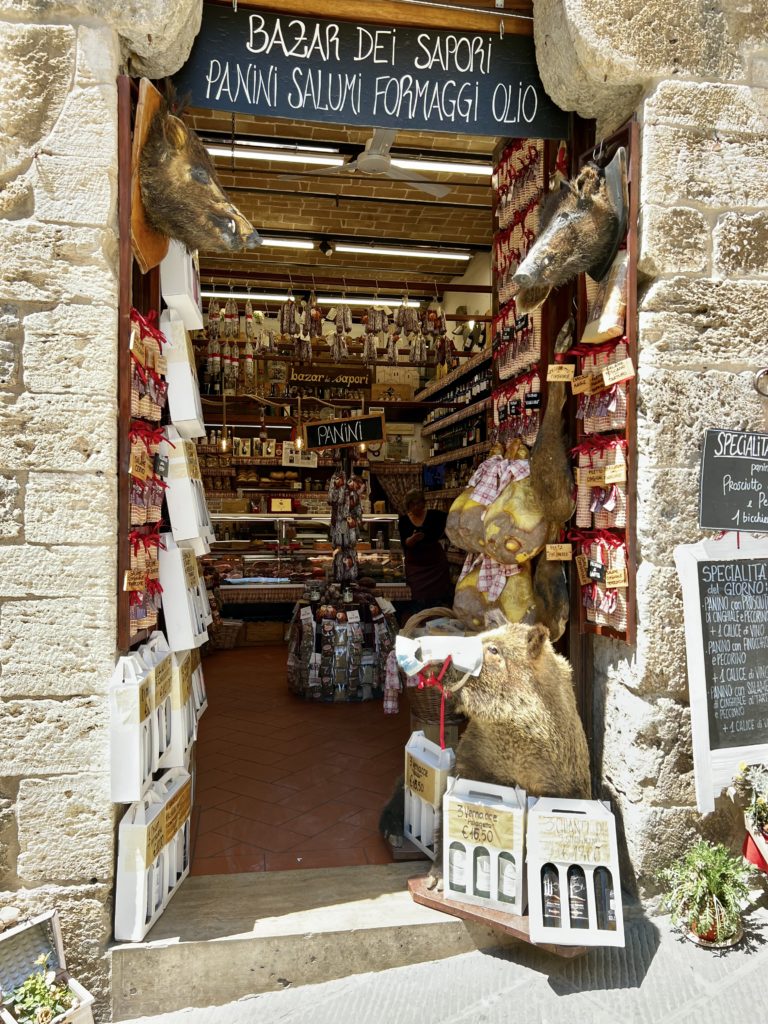
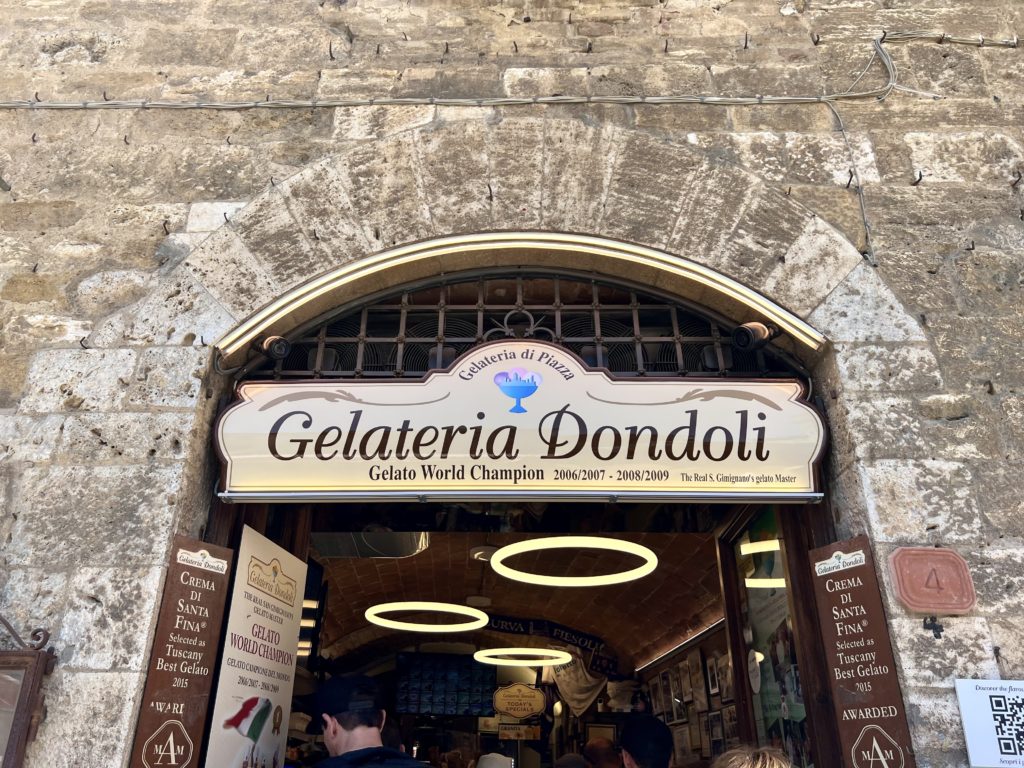
6. Where To Eat In San Gimignano
Sam Gimignano is loaded with wonderful restaurants. For great meals, check out Locanda di Sant’Agostino, Osteria del Carcere, La Mangiatoia,or Bar Enoteca Gustavo. You also find panini shops on every street.
If you want to splurge on dinner, reserve at LINFA, San Gimignano’s Michelin-starred restaurant. If you want spectacular views as you dine, try Le Vecchio Mura. Cum Quibus is Italian dining at its finest, with creative takes on classic Tuscan dishes.
For gelato, the most popular place is Gelateria Dondoli. The perpetual long lines confirm its popularity.
But have no fear, there’s another gelato shop right next door, which claims to have the world’s best ice cream.
7. Where To Stay In San Gimignano
If you want to stay overnight in San Gimignano, you have several options. If you want to be near the main attractions, try Hotel Cisterna or Hotel Leon Bianco.
La Collegiata is a stunning hotel that gives you a luxury stay in a former monastery. It’s a place of pared back elegance with antiques and white washed rooms.
Another fantastic option is Il Segreto di Pietrafitta. It’s one of Italy’s famed agriturismo (farm) stays. It’s a rambling mansion with big open fireplaces, brick ceilings, and terracotta floors.
On my last visit, I was lucky to stay at Borgo San Felice, which is about an hour from the town. It’s essentially a medieval stone village that’s been transformed into a luxury hotel.
I hope you’ve enjoyed my guide to the best things to do and see in San Gimignano. You may enjoy these other Tuscany travel guides and resources:
- 1 day itinerary for Florence
- 3 day itinerary for Florence
- Best museums in Florence
- Hidden gems in Florence
- Must see sites in Florence
- 1 day itinerary for Siena
- 10 day itinerary for Tuscany
- Tuscany art bucket list
- Top Attractions in Pisa
If you’d like see the top must visit attractions in the town of San Gimignano, pin it for later.

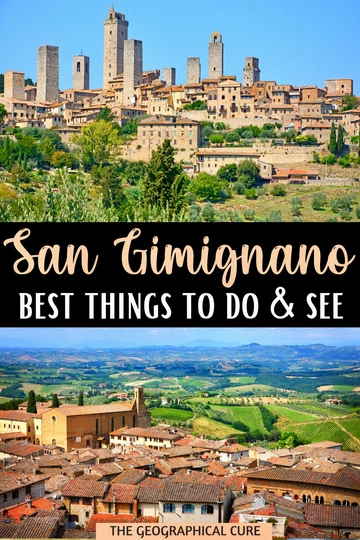
Fantastic info. Thanks so much!
Thank you so much Fiona!
This is amazing Fiona,
concise, organised, a great read and very informative.
Thank you Anthony!
Sorry, I meant Leslie 🙂
I wish all reviews and suggestions to do one can find online were as well presented as this one! Thanks so much for helping me organize our day in San Gimignano in March, 2023.
Thank you Rob! It’s a great little town. Enjoy!
Thank you for all the information. Makes planning so much easier. Looking forward to visit in May
You’re welcome! Enjoy all the great things to do in San Gimignano!